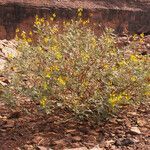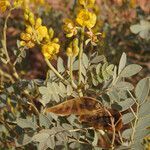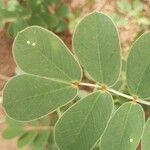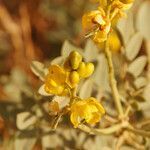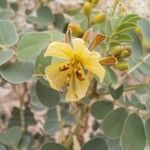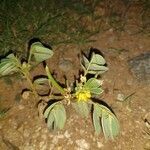Perennial herb with several prostrate to decumbent, branched stems up to 40 cm high, or a sub-shrub, more erect and up to 60 cm high (unusual in Flora area), from a woody rootstock with long, thick roots. Stems when young slightly flattened, ± glandular and viscid to eglandular, minutely pubescent with short thick patent hairs becoming glabrescent with age, or appearing glabrous but with densely packed, microscopic, straight or curved hairs, or appressed pubescent with fine straight hairs lying parallel with surface, or densely pilose with long, slender patent hairs, becoming ± terete (sometimes with 1 or more marked furrows), non viscid, glabrescent, glabrous or remaining densely pilose with age. Leaves variable in size: petiole and rhachis (2-)4-10(-12) cm long; stipules persistent, asymmetric, hastate or ovate-triangular, 3.5-8(-11) mm long, 2-2.5 mm wide, with a well-marked mid-vein, glabrescent with short patent hairs especially on margins; petiole 0.3-3.5 cm long including basal pulvinus, petiole and rhachis eglandular (except for numerous small finger-like glands in the leaf axils and adaxially on the rhachis between each pair of leaflets); leaflets in (3-)4-6(-9) pairs, oblong, obovate-oblong or obovate-elliptic, 1-3.8 (-4.3) cm long, (0.4-)1-2.5(-2.7) cm wide, uppermost pair not always largest, bases asymmetric, apices emarginate, rounded or obtuse, sometimes mucronate, margins orange with short, scattered hairs, surfaces minutely glandular or eglandular, glabrous, glabrescent, pubescent or densely villous with hairs varying from minute and straight or curved or appressed to long and patent. Inflorescences axillary racemes, including naked peduncles, 2-15(-25) cm long, many-flowered; bracts 3-5.5 mm long, 3-5 mm wide, ovate, acuminate, deciduous ± at flower opening; pedicels, at flowering, ±3 mm long, not much elongated at fruiting. Sepals obtuse. Petals sub-equal, obovate, (5-)7-12(-20) mm long, (2.7-)5-7(-10) mm wide, bright yellow to yellowish-white becoming brown-veined with age. Stamens 10:3 adaxial reduced, ± staminodal with ± flattened filaments, 4 lateral and 1 central-abaxial medium-sized, 2-3.3 mm long, 2 lateral-abaxial large, 5-8 mm long, curved, dehiscence porose. Ovaries glabrous or white pubescent with minute straight, curved, or appressed hairs, or densely pilose with long patent hairs; style 3-7 mm long, bent at 70°-90° to ovary, or ± coiled; stigma either hardly wider than width of style narrowing apically into a small ± circular to elliptic aperture, or flared into an asymmetric trumpet markedly wider than style. Pods flattened, rather variable in size and shape, generally ± oblong to sub-orbicular, often slightly upwardly falcate 2-4(-6) cm long, 1.3-2.5 cm wide, apex beaked, valves membranous, evidently veined, brown, with a median line of crests (lacking in some plants from eastern Transvaal and Natal), glabrous or minutely pubescent or villous. Seeds laterally compressed, ± ovate, 6-7 mm long, ±4 mm wide, testa brown, reticulate-rugose; areole central on each lateral face, oblong, faintly transversely-striate, ±2 mm long, ±0.5 mm wide.
More
Leaves paripinnate; stipules 5–6 × 1 mm, narrowly triangular, pubescent, persistent; petiole 0.3–2 cm long, pubescent; rachis 5.5–8 cm long, pubescent, eglandular or with a very small reddish gland between the leaflet pairs; leaflets in (4)5–7(8) pairs, 1.6–3.6 × 0.6–2 cm, the distal largest, oblong to broadly obovate, base broadly cuneate or rounded, slightly asymmetric, apex obtuse to rounded or retuse, usually mucronate, glabrous to sparsely pubescent, the margin and midrib beneath more densely pubescent; petiolules up to 1 mm long, glabrous to pubescent.
A herb or small shrub. It keeps growing from year to year. It can grow 1 m tall. It has a taproot. The base is woody and the stems are soft. It lies along the ground and has upright flower stalks. The leaves are compound with leaflets along the stalk. They have 3-7 pairs of leaflets. These are unequal in shape and oval. The flowers are yellow. They are 2-2.5 cm across. The fruit are large pods that are flat and have a ridge along them. There are some subspecies.
Stamens 10; two fertile with long arcuate anthers and very short filaments; five fertile with short straight anthers and straight filaments; three probably sterile with anthers curved into a semi-circle and straight filaments.
Pod weakly curved to almost straight, flattened, usually bearing distinct crests on the flat faces in the middle of each segment, mucronate (style-base), tardily dehiscent along both sutures.
Inflorescences axillary many-flowered racemes, 7–26 cm long, including the peduncle; bracts c.5 × 3 mm, broadly ovate, acuminate, pubescent, caducous; pedicels 2–3 mm long at anthesis.
Seeds brown, 6–7 × 2–3 mm, obovate, flattened, with a narrowly elliptic areole c.2 mm long on each broad face.
Prostrate or ascending shrublet or herb from a woody base, to 15–60 cm high.
Ovary flattened, glabrous to villous; style terete; stigma terminal.
Branchlets pale grey-brown, pubescent, weakly longitudinally ridged.
Petals orange to yellow, obovate, slightly unequal.
Sepals 5, elliptic to obovate, glabrous.
Can be grown by seedlings. Seeds needs soaking.
